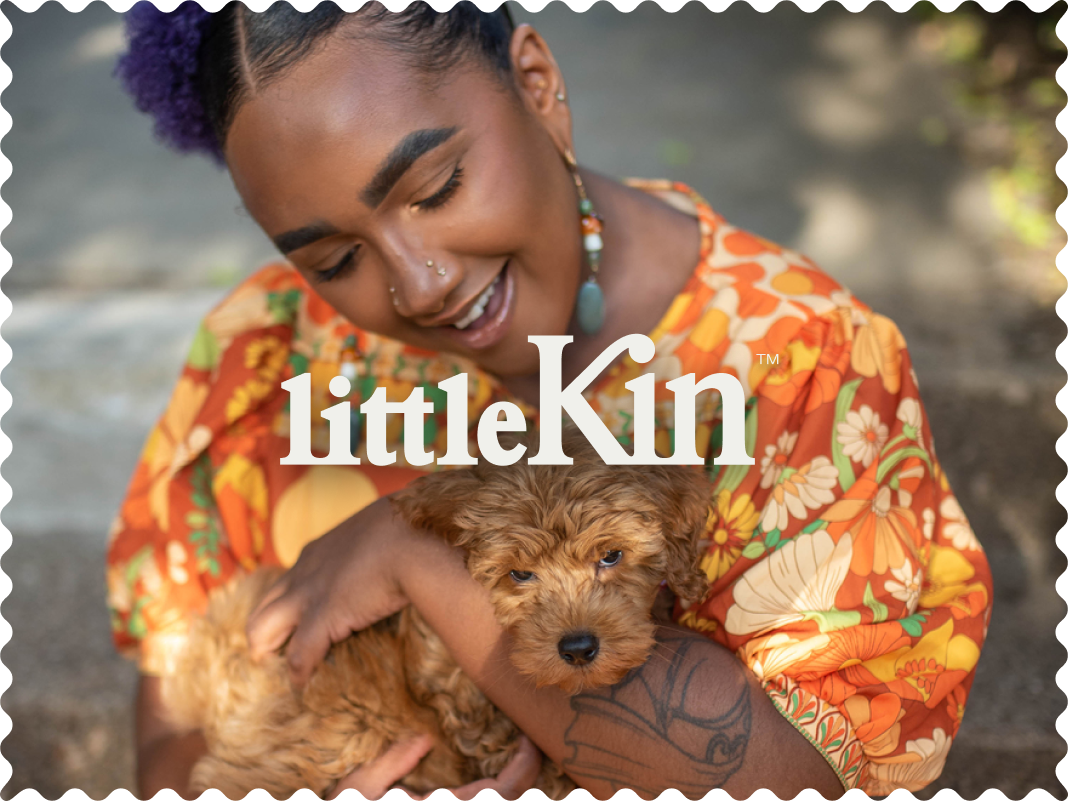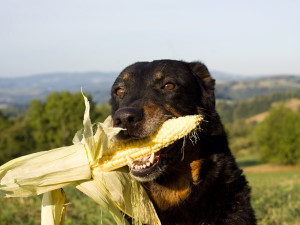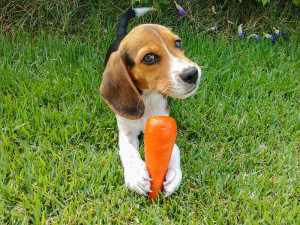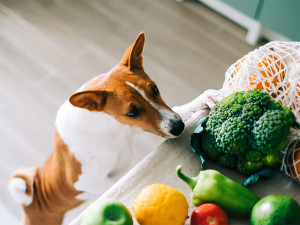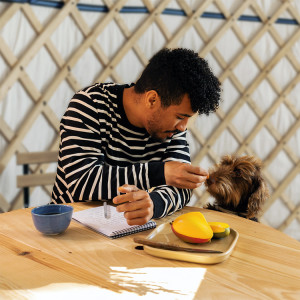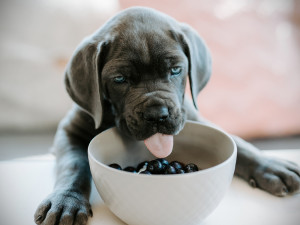Can Dogs Have Ham?
That might be what you’re having for dinner, but read here to see if your dog can partake.

Share Article
In This Article: Can Dogs Eat Ham? How Much Ham Can Your Dog Safely Eat? What Other Holiday Foods Are Bad for Your Dog? Foods to Give Your Dog Besides Ham What Happens if Your Dog Eats Too Much Ham?
Smoky, with a little bit of sweetness — this is what makes ham irresistible, glazed or in a sandwich. We even like it as leftovers. Trust me, your dog probably shares your affection for ham, and who could blame them? Although ham isn’t toxic, it doesn’t have a place in your dog’s food bowl. Read on to find out why.
Can dogs eat ham?
Ham and other pork products aren’t toxic to dogs, so they won’t have an immediate reaction if they eat some. The issue with ham (and other meats like it) is when dogs eat more than a taste. That’s when they might experience things like diarrhea, vomiting, stomach pain, and more.

Is ham good for dogs?
Dogs may love the taste of ham — and there may be no better way of getting them to do tricks or obedience commands than when a piece is offered — but it shouldn’t be a treat of choice. As a meat, it may be high in protein, but if you’re feeding your pup good-quality food that’s complete and balanced, they don’t need ham. In fact, eating too much of it could be dangerous.
Can ham be bad for dogs?
Ham is high in all kinds of things that could be bad for dogs, including salt, fat, and maybe even sugar. High amounts of salt can lead to health problems such as high blood pressure, kidney disease, and something called salt toxicityopens in new tab. High amounts of fat can bring on pancreatitisopens in new tab and, over time, weight gain and obesity.
If those weren’t bad enough, ham can contain high amounts of sugar, which can also lead to weight gain and obesity. Meanwhile, other seasonings, including garlic and onion, can be toxic to them. So, feeding your dog ham has far more minuses than it does pluses.
Can dogs have ham bones?
Although many dog-related things may have cute, bone-shaped designs, bones aren’t something you’ll want to give to your dog. Cooked bones are especially bad because they are brittle and can splinter or break when your dog chews them. Swallowing those sharp pieces can cause injuries or perforations in a pup’s digestive tract.
How much ham can your dog safely eat?
It’s likely that a bite or two of ham won’t make much of a difference for your pup. You just don’t want to give them all they want or replace a meal with ham. If you choose to give your pup a nibble of ham, stick with a lean cut free of seasonings and sugar. Give your dog a couple of bites at most, let them enjoy it, and then move on to a healthier treat.
What other holiday foods are bad for your dog?
Although ham is served any time of year, it is a popular food around the holiday season. Generally speaking, you’ll want to find ways to celebrate the holidays other than sharing your meal with your pup. All those holiday favorites that we enjoy aren’t so enjoyable for your dog’s body. Things such as mashed potatoes may seem harmless, but when loaded with butter, milk or cream, and seasonings, they can kick off a digestive nightmare for your pooch.
Sweets and alcohol are also off limits, as are creamed or candied anything. Fatty cuts of meat, yeast dough, and macadamia nuts are also no-gos. And as you probably already know, grapes, raisins, and chocolate are toxic as well. When in doubt, don’t feed your dog from the holiday table.
Foods you can give your dog besides ham
We understand that, especially during the holidays, you want to spread cheer to your pup. Stick with a few of these healthy options to treat them, but be sure to keep the amounts in moderation:
Bananas
Cucumber
Berries
Peas
Green beans
Lean meats
Cooked eggs
Whole grain bread
Thoroughly wash all fruits and vegetables, remove the seeds/pits/cores, and serve plain without seasonings or sugar. Cook meat completely, and trim off any excess fat. Always speak to your vet before adding any human foods to your dog’s diet.
What happens if your dog eats too much ham?
Giving your dog too much ham can cause vomiting, diarrhea, and a reduced appetite. It can also lead to more severe things, such as high blood pressure, kidney disease, pancreatitis, weight gain, or salt toxicity.
Bottom line
Ham is too high in salt, fat, and potentially other seasonings to be part of your dog’s dinner.
Giving your dog too much ham can cause vomiting, diarrhea, and a reduced appetite. It can also lead to more severe things, such as pancreatitis, weight gain, or salt toxicity.
If you choose to give your dog ham, trim off the fat and make sure it does not have things such as garlic, sugar, or onion added to it.
References
Brooks, Wendy, DVM, DABVP. “Pancreatitis in Dogs.” Veterinary Partner. 18 Jun 2023. veterinarypartner.vin.com/default.aspx?pid=19239&id=4952412opens in new tab.
Thompson, Larry, DVM, PhD, DABVT. “Salt Toxicosis in Animals.” Merck Veterinary Manual. Sep 2024.www.merckvetmanual.com/toxicology/salt-toxicosis/salt-toxicosis-in-animalsopens in new tab.

Dr. Chyrle Bonk, DVM
Dr. Chyrle Bonk has been a mixed-animal veterinarian since 2010, with a special interest in rehabilitation. When she's not practicing or writing about veterinary medicine, you may find her exploring the outdoors with her family or tending to her cows, horses, chickens, or cats and dogs.

Rebecca Caplan
Rebecca Caplan is a writer based in Brooklyn whose work has been featured in The New Yorker, Reductress, and Vulture. She lives in Brooklyn with her perfect, toothless dog Moose.
Related articles
Can Dogs Eat Mango?
The delicious fruit is safe in moderation.
![Curious Basenji dog puppy climbs on the table with fresh vegetables at home in the kitchen.]()
Can Dogs Eat Broccoli?
Find out how to safely get your pup their greens.
Can Dogs Eat Shrimp?
Is your pup a seafood fan? Find out everything you need to know about feeding them shrimp.
![a dog by biscuits and a Christmas tree]()
The Holidays Are Prime Time for Pancreatitis—Here’s How to Protect Your Dog
With all the festivities (and eating!) afoot, it’s extra important to know how to prevent the disease.
![Various Veggie Chips in a Ceramic Blue Bowl]()
Can Dogs Eat Sweet Potatoes?
Add it to the list of healthy human superfoods pups can eat, too.
![Puppy eating a bowl of blueberries]()
10 Superfoods You Should Share With Your New Dog
From kale to quinoa, these nutrient-packed picks deserve a spot in your dog’s food bowl.
